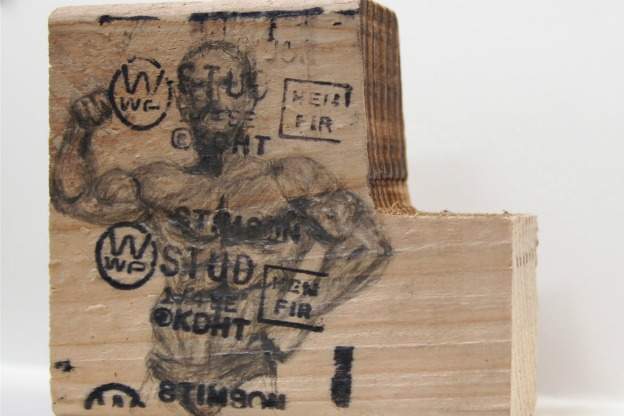
In discussions of the visual arts over the last few decades, there may be no term that has generated more rhetoric-and elicited more groansthan "the male gaze".
We know the drill: the history of art is a succession of images of women represented by men. Woman is object, man is subject.
"When you look at a woman you see beauty," summarizes Brenda Oelbaum, National Midwest Vice President for the Women's Caucus for Art, a national advocacy organization for female artists and art historians. "And I think it's because we've been seeing it for thousands of years. We've been told that this is beauty."
Subverting The Paradigm
In response, Oelbaum conceived of an exhibition that casts the male in the role of object of aesthetic inquiry. Presented by the Women's Caucus for Art, "Man As Object: Reversing the Gaze" examines the male body and the expression of masculinity from female, feminist, and transgender perspectives.
When the juried show was mounted at the SOMArts Cultural Center in San Francisco in November 2011, it featured the work of 117 artists, including such headliners in the feminist art world as Carolee Schneemann, Annie Sprinkle, and Guerrilla Girls.
For the opening of "Man As Object" at the Kinsey Institute Gallery April 13, nine of the artists represented in the show traveled from around the country for a reception and panel discussion.
"This image is from a series that shows all my favorite male body parts," photographer Della Calfee commented, about her sepia-toned, three-quarter view of the back of a standing male torso. "I've heard men artists speak like this, but I've never heard a woman artist speak like this, and it does feel pretty awkward. "
Room With A View
"My sexual history is really boring," joked panelist Laura Hartford, whose photograph Eric with Flowers is in the Kinsey's permanent collection. "I've had a 46-year phase of heterosexuality. And so if I have to be in a room with pictures, I'd rather look at a bunch of good looking guys on the wall than female nudes."
Hartford's nude male subjects recline like odalisques or are draped with garlands of flowers like pre-Raphaelite beauties.
"My work is a reaction to women always looking at themselves as an object versus looking outside themselves towards what they're actually drawn to," Hartford explained. "I think it's really important that women's work reflect their own sexuality rather than what we as a culture have decided we should be looking at, which is naked women."
Beyond Either/Or
Painter Molly Nuzzo tackles the heterosexual underpinnings of the the polemic between male subject and female object. "The idea of the male gaze exists within a heterosexual framework, as does the idea of reversing the gaze." Using young transgender men as her models, Nuzzo explores how to "queer the gaze. What happens when we view a body outside of that binary framework?"
Making a place for those explorations is a big part of Karen Gutfreund's job. The show's organizer is the National Exhibitions Director for the Women's Caucus for Art. The organization was founded in 1972 as an affiliate of the College Art Association, and functions to create exhibition opportunities for and provide education about women artists, to increase the acquisition of work by women by museums and significant art collections, and to celebrate and advocate for the role of women in the visual arts.
You've Come A Long Way, Baby
Feminism and artmaking have been complementary pieces of photographer Patricia Izzo's trajectory. Having grown up in a fairly traditional Italian-American family, Izzo came of age in the 1960s, and hailed the establishment of the National Organization for Women.
"That changed me entirely," recalled Izzo; "it changed my art; it changed a lot about me. I was a feminist without even knowing what the word meant."
Izzo's intuitive feminism comes across in the uncontrived sensuality of her image, One Night Stand, in which the viewer gets to ogle a half-clad young man looking away, while he finishes a cigarette. The subtext of the title, Izzo explains , is that, "it's her one night stand. Turnabout is fair play."
Gutfreund is convinced that mainstream culture is starting to incorporate the ways women look at men.
"I'm thinking of that David Beckham ad during the Superbowl, with the camera lovingly circling his beautiful body," noted Gutfreund. "Of course it was an an advertisement, but if we can have that during the Superbowl…it's like, wow!"
"You can look just as easily as a man, and why not?" Izzo asked. "The taboo's been lifted."






